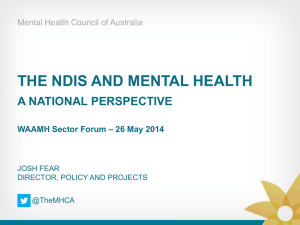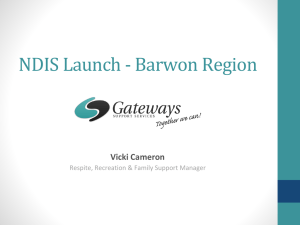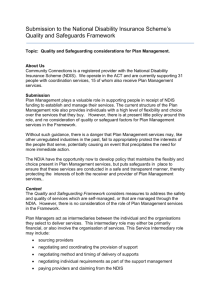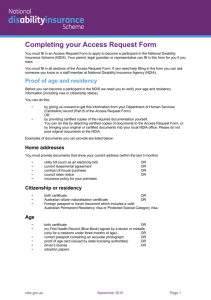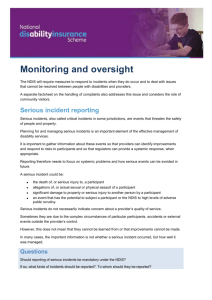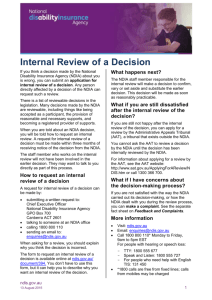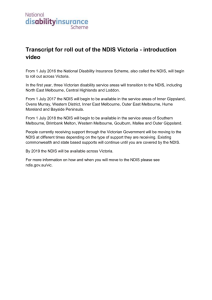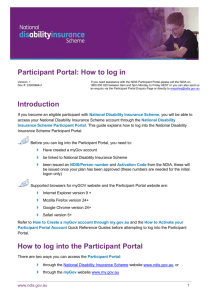NDIS-Safeguards-Submission-LifeLinks-City-of-Holdfast
advertisement
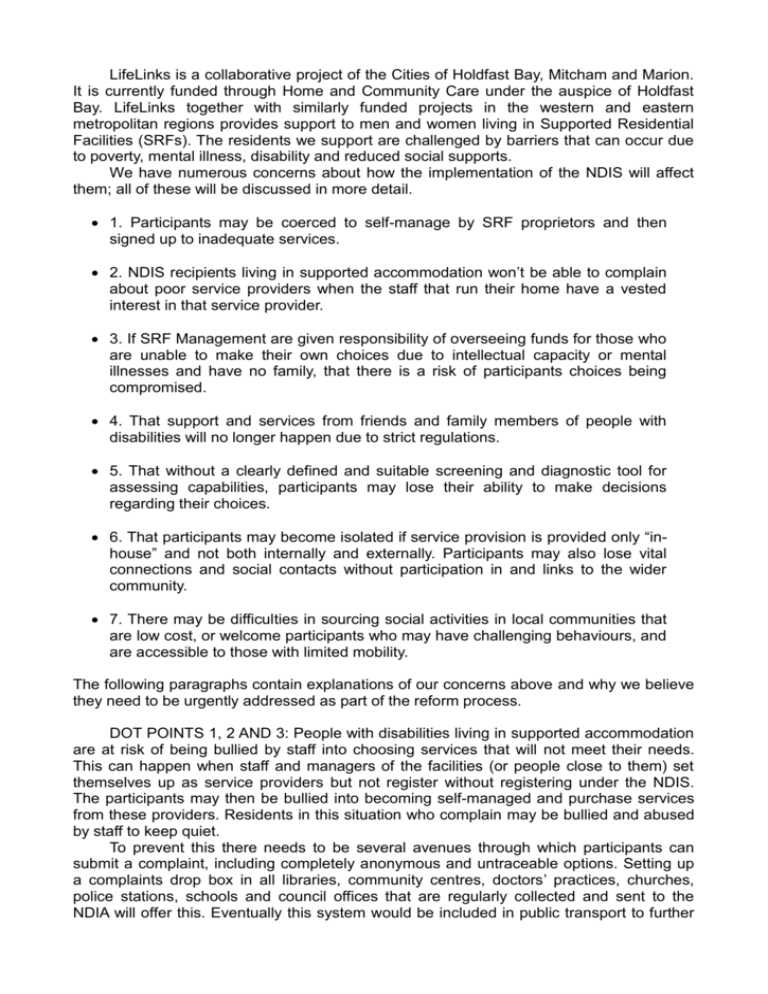
LifeLinks is a collaborative project of the Cities of Holdfast Bay, Mitcham and Marion. It is currently funded through Home and Community Care under the auspice of Holdfast Bay. LifeLinks together with similarly funded projects in the western and eastern metropolitan regions provides support to men and women living in Supported Residential Facilities (SRFs). The residents we support are challenged by barriers that can occur due to poverty, mental illness, disability and reduced social supports. We have numerous concerns about how the implementation of the NDIS will affect them; all of these will be discussed in more detail. 1. Participants may be coerced to self-manage by SRF proprietors and then signed up to inadequate services. 2. NDIS recipients living in supported accommodation won’t be able to complain about poor service providers when the staff that run their home have a vested interest in that service provider. 3. If SRF Management are given responsibility of overseeing funds for those who are unable to make their own choices due to intellectual capacity or mental illnesses and have no family, that there is a risk of participants choices being compromised. 4. That support and services from friends and family members of people with disabilities will no longer happen due to strict regulations. 5. That without a clearly defined and suitable screening and diagnostic tool for assessing capabilities, participants may lose their ability to make decisions regarding their choices. 6. That participants may become isolated if service provision is provided only “inhouse” and not both internally and externally. Participants may also lose vital connections and social contacts without participation in and links to the wider community. 7. There may be difficulties in sourcing social activities in local communities that are low cost, or welcome participants who may have challenging behaviours, and are accessible to those with limited mobility. The following paragraphs contain explanations of our concerns above and why we believe they need to be urgently addressed as part of the reform process. DOT POINTS 1, 2 AND 3: People with disabilities living in supported accommodation are at risk of being bullied by staff into choosing services that will not meet their needs. This can happen when staff and managers of the facilities (or people close to them) set themselves up as service providers but not register without registering under the NDIS. The participants may then be bullied into becoming self-managed and purchase services from these providers. Residents in this situation who complain may be bullied and abused by staff to keep quiet. To prevent this there needs to be several avenues through which participants can submit a complaint, including completely anonymous and untraceable options. Setting up a complaints drop box in all libraries, community centres, doctors’ practices, churches, police stations, schools and council offices that are regularly collected and sent to the NDIA will offer this. Eventually this system would be included in public transport to further increase protection for vulnerable people. For those unable to communicate in a written form, there could be a specific role assigned to a worker within the NDIA operational structure whose primary task would be to visit each of those clients privately for verbal feedback on a regular basis. There also needs to be a registration requirement from all providers, based on a sliding scale, as per dot point 4 below. An ideal situation would be if participants of the NDIS have their services purchased and managed by the NDIA initially and then can apply to be self-managed. This application process would act as a natural competency check. There would need to be support from family and friends during this process. In the case of participants that have no family or friends they would need support from health care professionals during this process to ensure that self-management is in the best interests of the person at hand. DOT POINT 4: Participants are at risk of losing support from friends and families if too many regulations get in the way of providing services. Registration and screening both need to be flexible to allow this them to maintain these supports. For example if an individual is doing gardening for only one participant they should not have the same screening and checks as a nationwide organisation providing numerous services to thousands of participants. There needs to be a sliding scale of screening diagnostics according to the amount of service providers involved ranging from a single person through to the largest companies. Within this framework there would need to be set a basic standard of assurances that spans all levels, but with flexible allowances for participants or families to make independent choices, especially in the case of a single person providing a service. A participant’s friends and family can act as safe guards for quality assurance of services coming from a provider only providing services to that one participant. Should the service provided not be high enough quality or the service provider puts the participant at risk the participant’s friends and family can step in and assist to cease that service and purchase an alternative service. This will only work when the participant has at least two friends or family members that care for them. When this is not the case an independent advocate needs to be assigned to monitor service provision. DOT POINT 5: There needs to be a suitable diagnostic assessment tool of people with intellectual disabilities or mental illnesses. This also needs to incorporate a wide viewpoint of the participant, including doctor’s, family, friends, support workers, as well as the client’s view to gain a well-balanced overall picture of their abilities/disabilities. This information could then be used in conjunction with a general assessment process to determine their level of functioning. The general assessment needs to be formulated in conjunction with professional health workers with specific skills in the field. DOT POINT 6: If service provision becomes “in house” only with social activities to resemble a nursing home structure, (to possibly maximize use of funds), then participants may become isolated from the community. They can then lose the skills and confidence they have developed over a number of years to interact and connect with people and organisations externally. Furthermore, new entrants to the facilities may then not receive the opportunity to learn these skills. Another problem with this option is it may increase the tendencies to smoke and live sedentary lifestyles, which was a major issue when LifeLinks began its service delivery in 2003, where a high percentage of participants were in this category. Currently the LifeLinks program provides social support, where clients are either linked to activities in the community or supported to attend, or offers participants free or low cost activities run by the program (i.e. gold coin donation). These activities allow the participants to integrate with members of other facilities, whom they may have, friendships with, or with people from their community where they can forge new friendships and connections. LifeLinks currently offers both individual support and group sessions (with participants coming from 8 facilities over 3 council areas). With greater participation in activities and external community involvement, there has been a significant improvement in health and wellbeing of participants. LifeLinks has spent a number of years building relationships with participants to foster the qualities of re-enablement and empowerment. DOT POINT 7: One of the key challenges encountered in delivering social support to participants has been to find activities that are in the local area that are suited to the special needs of participants. Often participants are lacking in basic skills both at a physical level and mental level, and therefore courses run in the general community are not suited to them. They often require support or special instruction to participate in general activities. Also they often need to have activities designed especially for their restricted abilities. These usually do not exist in general community. A further issue is that even if a course or activity is found that is free or low cost in the community, the members of the group may not welcome people who may sometimes have difficult or challenging behaviours due to their illness. There are also times when judgement and stigma are directed to participants in relation to their illnesses, due to preformed beliefs and a lack of education regarding intellectual and mental illnesses within the public arena. The other obstacle to participation in activities is transport. Many participants are not able to catch public transport either due to physical or intellectual limitations. This then affects their ability to participate. Also participants are often reticent to attend an activity unless they have transport support to attend. This can be a result of the side effects of their mental illness or medications which often leave them feeling depressed or tired, where they need a worker motivating them to participate. Also the cost of transport is an issue for most participants, with a huge portion of their pension going to the facility for board, food and medication, and a very small amount left over for their other requirements. SUMMARY 1. Participants of the NDIS should have their services purchased and managed by the NDIA initially and then can apply to be self-managed. 2. A suitable complaints strategy needs to be in place for participants, with anonymity being the primary concern 3. A sliding scale of screening diagnostics for service providers, with flexibility built in for independent decisions by clients, family and friends. 4. A suitable diagnostic assessment tool of people with intellectual disabilities or mental illnesses needs to be formulated with a big picture approach 5. Any service provision needs to account for both individual and group activities, provided both internally and externally. 6. Structure of social support needs to account for issues such as transport assistance, availability of special needs activities or support networks for participants to engage in community activities, high costs associated with activities available in the community, and motivational support for participation.
